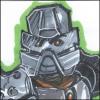
We got to Sheridan not too long after, where we stopped to eat at a Jimmy John's where the employees far outnumbered the customers. (Many on the Jimmy John's payroll just sort of stood around in the back, likely feeling as awkward as their expressions denoted.)
After Sheridan, there was nothing else to do but get up to Billings. The drive was broken up by occasional bits of road work (well, "road work" in the sense that they blocked off a perfectly good lane yet were not working on it whatsoever). We had traveled this route in the opposite direction on our first trip in going from Billings to Devils Tower, and thus passed by the Little Bighorn battlefield, although we did not stop a second time.
Billings, like many western cities, is spread out. My dad noted that its three skyscrapers were "about six stories each." We got to our hotel before 3:00 and proceeded to unpack everything from the car.
The unpacking ordeal, which we had endured for every day of the trip, consisted of the awkward carrying-in of multiple bags in the evenings and attempting to figure out how in the world we'd packed it again in the mornings. There's more than enough room in the hatchback for everything we have, but keeping it so we can see out means packing it a particular way.
So, before a set of much longer days, we decided to pull everything out of the car and haul it into our room. This took two trips for everyone, although we were much more weighed down on the first trip. The room has subsequently been strewn with bags and articles of clothing in an effort to properly re-pack the mess it had devolved into.
Before the epic day tomorrow, we wanted to eat a big dinner. We searched a few local places and asked the front desk about them. The front desk knew nothing about any of these places, so we just decided to go out and see what we could find along one of the main streets around town.
We went towards downtown only to run into a residential district, and then were unable to turn around easily. Eventually we went back the other direction on the same road. We knew that the road led to food, but we didn't run into any of them. We ran into grocery stores, gas stations, casinos, dog parks, and industrial parks ... but there was no food to be found.
Exasperation reached an all-time high. We found ourselves, eventually, in a Popeye's. I'd never been in a Popeye's and in fact had only ever seen them on commercials. We ordered an assortment of chicken and sides, and it was filling.
Of most notability there was their drink machine: a high-tech touch-screen monstrosity that would burp out any drink you wanted so long as you could get it to cooperate. I had two big drinks of raspberry lemonade from this thing.
Tomorrow: the longest day of any trip we've taken thus far, starting at dawn towards Yellowstone National Park via the extraordinarily beautiful Beartooth Highway.
- Read more...
- 2 comments
- 263 views

